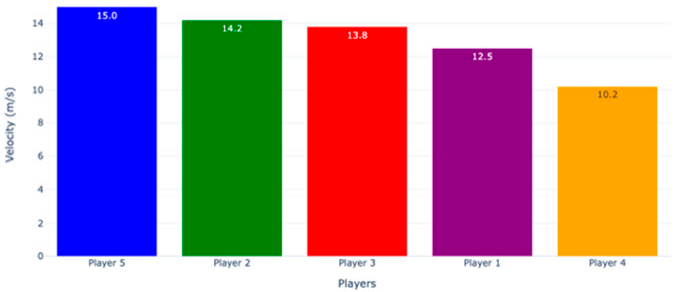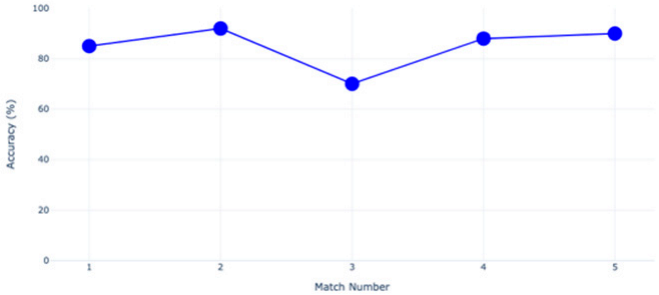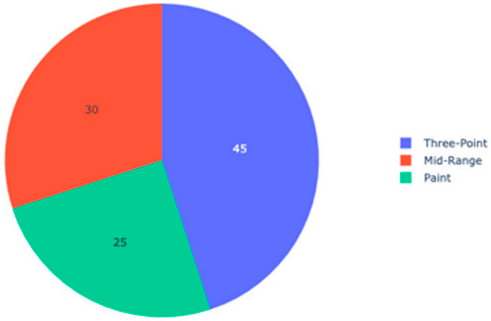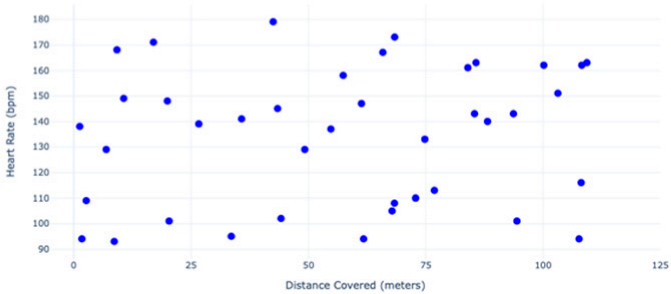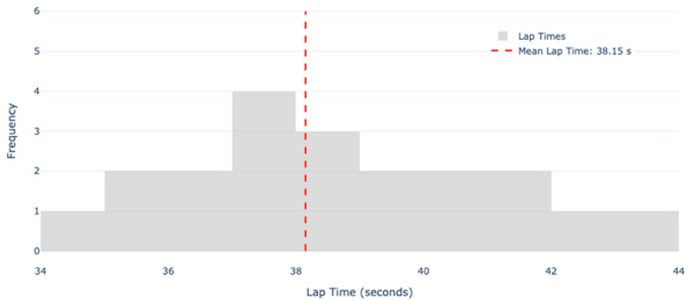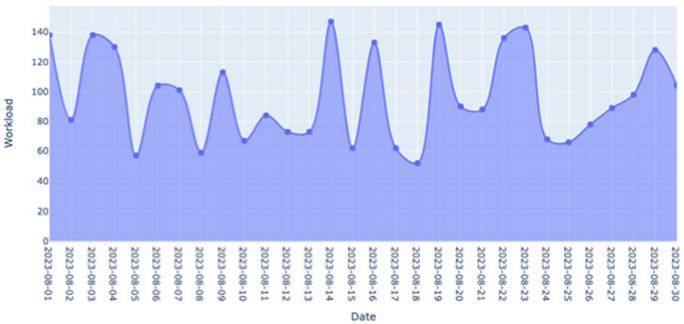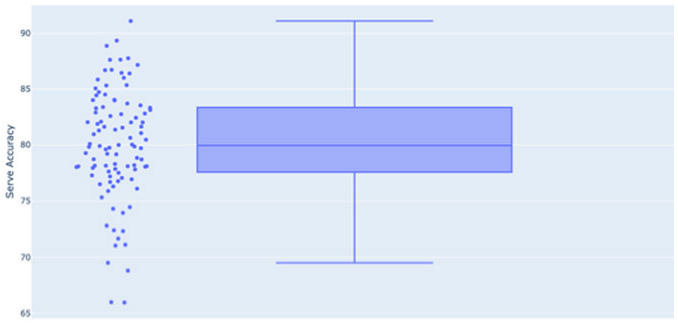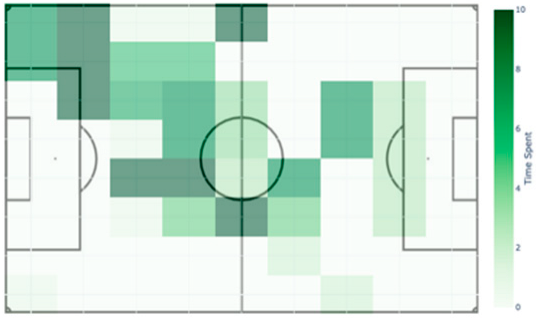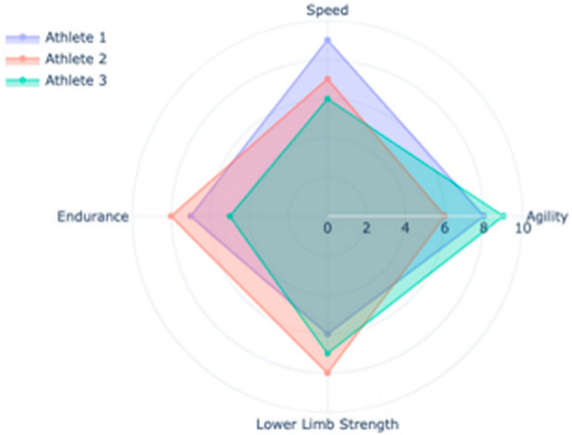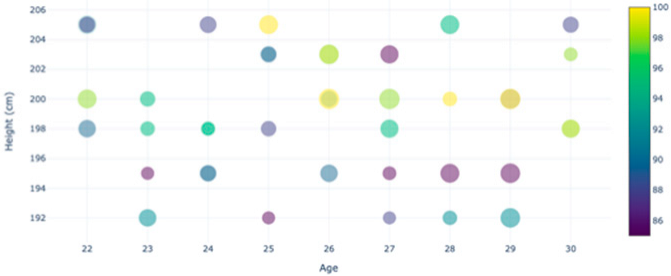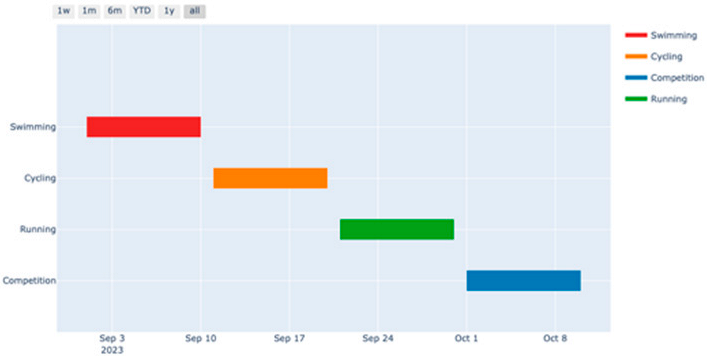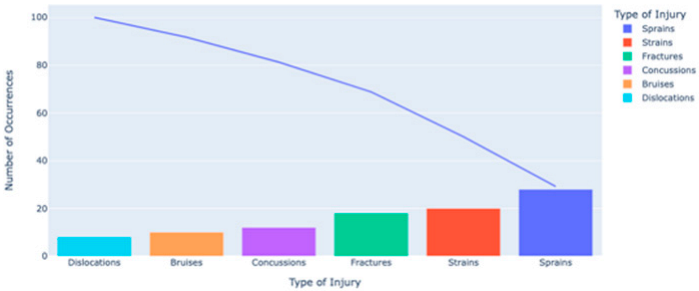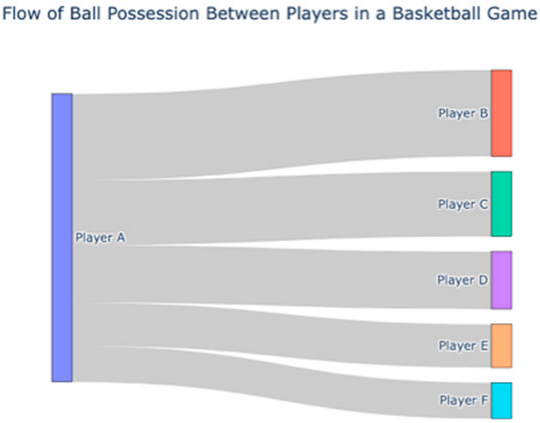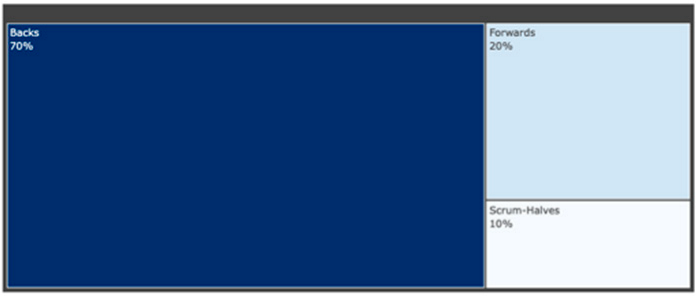Abstract
We are currently witnessing an unprecedented era of digital transformation in sports, driven by the revolutions in Artificial Intelligence (AI), Virtual Reality (VR), Augmented Reality (AR), and Data Visualization (DV). These technologies hold the promise of redefining sports performance analysis, automating data collection, creating immersive training environments, and enhancing decision-making processes. Traditionally, performance analysis in sports relied on manual data collection, subjective observations, and standard statistical models. These methods, while effective, had limitations in terms of time and subjectivity. However, recent advances in technology have ushered in a new era of objective and real-time performance analysis. AI has revolutionized sports analysis by streamlining data collection, processing vast datasets, and automating information synthesis. VR introduces highly realistic training environments, allowing athletes to train and refine their skills in controlled settings. AR overlays digital information onto the real sports environment, providing real-time feedback and facilitating tactical planning. DV techniques convert complex data into visual representations, improving the understanding of performance metrics. In this paper, we explore the potential of these emerging technologies to transform sports performance analysis, offering valuable resources to coaches and athletes. We aim to enhance athletes’ performance, optimize training strategies, and inform decision-making processes. Additionally, we identify challenges and propose solutions for integrating these technologies into current sports analysis practices. This narrative review provides a comprehensive analysis of the historical context and evolution of performance analysis in sports science, highlighting current methods’ merits and limitations. It delves into the transformative potential of AI, VR, AR, and DV, offering insights into how these tools can be integrated into a theoretical model.
1. Introduction
We are witnessing an unprecedented era of digital transformation in sports, powered by the revolutions in Artificial Intelligence (AI), Virtual Reality (VR), Augmented Reality (AR), and Data Visualization (DV). Effectively integrating these powerful resources into sports is an exciting challenge. Each tool offers unique solutions and applications to redefine the landscape of sports performance analysis [1,2,3,4,5]. Through these technologies, we can revolutionize performance analysis by automating data collection, processing vast datasets, interpreting performance, providing immersive training environments, offering real-time augmented feedback, and enhancing the decision-making process [1,6,7].
Performance analysis is a crucial element in sports science, playing a pivotal role in understanding, interpreting, and ultimately improving an athlete’s performance [8,9,10,11]. It serves as an indispensable tool that assists athletes, coaches, and sports analysts in making informed strategic and tactical decisions that can significantly alter the outcome of competitive sports events [12,13].
Traditionally, the process of performance analysis has predominantly relied on manual data collection and/or input, subjective observational techniques, and standard statistical models [14]. Despite their proven efficacy, these methods often necessitate significant time and effort to implement, interpret, and apply [8,15]. Manual data collection involves meticulous documentation of numerous performance metrics, demanding not only extensive work hours but also a deep understanding of sport-specific parameters. Consequently, manual data collection is prone to observational biases and discrepancies that might arise due to the inherent subjectivity of human observation, leading to potential misinterpretation of performance data [4,9]. Similarly, while statistical models have been effectively used to decode patterns and inform strategies, they typically oversimplify the complex, dynamic nature of sports performance, often considering only limited variables and not adequately addressing the multifactorial aspects of sports performance [1,10,16]. These limitations are amplified when trying to analyze performance in real-time, where swift data processing and interpretation are essential [10,17,18,19]. However, technological advances in sports science have led to a transformative change in the field, bringing forth an era of enhanced, objective, and real-time performance analysis.
Recent AI tools captured the imagination of users and exponential adoption of the technology has exceeded any other innovation [20,21,22]. With AI’s ability to streamline data collection, process massive datasets quickly and accurately, synthesize information, predict outcomes, and create new knowledge, it will revolutionize work and play environments. Infinite possibilities exist for using AI with future outcomes that were previously inaccessible through traditional human analysis [23,24]. AI—a general term for many different technologies, such as neural networks, large language model transformers, and diffusion grids, which have been instrumental in finding previously unknown relationships in datasets and making predictions with astonishing accuracy—boasts the capability to automate data collection processes, reduce human error, and drastically decrease the time taken to gather information [6,25].
VR introduces the capability to create highly realistic, immersive training environments. These environments are not simple simulations; they are commonly understood as platforms that mimic the exact conditions of a real-world game or training scenario. Hence, VR is recognized as an immersive environment that goes beyond mere emulation [26,27,28]. The advancement beyond emulation and into near-reality provides athletes with a unique opportunity to train and refine their skills and gain a comprehensive understanding of their performance in a controlled setting [4].
Complementing the immersive experiences offered by VR, AR presents another technological advancement that blurs the line between the physical and digital worlds [29,30,31,32,33,34]. AR can overlay digital information onto the real-world sports environment, effectively creating an interactive platform that provides real-time performance analysis [30,32,33,34]. This technology can be used to analyze and provide instant feedback on an athlete’s technique, positioning, and movements, enabling immediate adjustments and refinements [30,32,33,34]. Such instant feedback mechanisms facilitate quicker learning and correction of errors, ultimately leading to improved performance. AR also holds promise in tactical planning. Coaches can overlay digital graphics onto the field of play to explain complex tactics and formations to players. This visual representation can enhance players’ understanding and implementation of strategies [35,36,37].
Complementing the abilities of AI, VR, and AR, dynamic and interactive DV techniques bring forth an entirely new dimension of performance analysis. By converting complex data into easily understandable visual representations, this technology allows coaches, athletes, and analysts to easily interpret and act upon performance metrics [38]. This enhanced communication of information leads to a more effective understanding of performance patterns, trends, and areas of improvement, thereby facilitating more informed decision-making processes [39,40].
In this paper, we explore the potential of continuous emerging technologies, including AI, VR, AR, and DV to significantly transform performance analysis within the sports domain. These technologies can automate data collection, provide immersive and realistic training environments, facilitate the processing and interpretation of complex performance data, and creatively provide digital feedback in real time. The ultimate objective is to assess the capacity of these technologies to provide coaches and athletes with valuable resources, enhance athletes’ performance, optimize training strategies, and inform physical, technical, and tactical decisions. We also sought to identify possible challenges and proposed solutions for integrating these technologies into current sports performance analysis practices.
2. Overview
This narrative review provides a comprehensive analysis of the brief historical context and evolution of performance analysis in sports science, highlighting both the merits and limitations of current methods. It includes brief reviews and definitions of all relevant topics. We then transition to an examination of the transformative potential of emerging technologies such as AI, VR, AR, and DV. We explore the potential of AI for automating data collection and processing, delve into the capabilities of VR and AR in creating immersive and interactive training environments, and assess the power of DV in translating complex data into digestible visual forms. Certainly, the topics are extensive, spanning decades of knowledge, and separate reviews could be conducted individually. Therefore, our approach focuses on providing a historical background along with the current state, particularly from the perspective of performance analysis, and exploring how these tools can be integrated into a theoretical model.
3. Performance Analysis in Sports
Performance analysis in sports refers to the systematic process of recording, analyzing, and interpreting performance data with the overarching aim of enhancing athletes’ or teams’ performance (Figure 1) [41,42,43]. This entails the careful observation and quantification of key performance indicators (KPIs), which vary across different sports modalities, such as individual pursuit (e.g., track cycling or swimming), collective sports (e.g., soccer or basketball), and endurance activities (e.g., marathon running or triathlon). These KPIs encompass a wide range of elements such as skills, techniques, tactics, and physiological parameters, which are meticulously scrutinized during both training sessions and competitive events [4]. Although the primary goal of performance analysis is to improve performance, it also plays a crucial role in injury prevention and future performance prediction, thereby assisting in talent discovery [44,45]. To achieve these goals, performance analysis employs a variety of methodologies, including observational analysis, video analysis, notational analysis, time-motion analysis, and data analysis from wearable devices [46,47,48,49,50,51,52,53,54,55,56,57,58]. Each of these techniques holds its unique role in contributing valuable insights into sports performance and can be defined as:

Figure 1.
Performance Analysis Model. The model depicts a comprehensive methodology for assessing athlete performance. Originating from sports events, such as training sessions or competitive matches, data are harnessed using a range of tools, from video recordings to wearables. Historically, sports analysts depended heavily on manual data input—a process that was often labor-intensive and subject to observational biases. In the modern landscape, the focus is shifting towards harnessing the power of integrated systems and Artificial Intelligence. These advanced techniques promise heightened objectivity, swift data processing, and the ability to apply insights in real time. Once gathered, these data are meticulously transformed to produce actionable insights aimed at enhancing athlete performance. These insights can be represented visually or in report format, serving as invaluable resources for athletes and coaches. The database section of the model emphasizes the adaptability of data storage solutions, ranging from structured relational databases to diverse multimedia platforms. Various environments, including virtual and mixed worlds, can be utilized to collect data and deliver data-driven tactical changes or training strategies.
- Observational Analysis: This refers to the methodical process of gathering, documenting, and assessing data by directly observing athletes or sporting events. It involves trained observers who meticulously record various facets of athletic performance. This analytical approach serves as a foundation for comprehensive assessments of athletes’ strengths, weaknesses, and areas for improvement. It can be performed using just the naked eye and recorded or supplemented with external data from different sources [4,59].
- Video Analysis: A technique that utilizes recorded game or training footage to study and review an athlete’s performance or a team’s tactical approach. It allows for the analysis of various aspects such as skills, techniques, player movement, and team formations. The use of various video speeds, from slow motion to frame-by-frame, enables intricate scrutiny of every action, providing detailed feedback to athletes and coaches [11,47,51,52,53,55,60,61].
- Notational Analysis: This systematic process involves the recording and analysis of discrete events that occur during a match or training session. Each event is notated or coded to provide a quantitative means of recording the performance. The data gathered provide an objective record of performance and can offer insights into the effectiveness of tactics, strategies, and individual player actions [10,56,62,63].
- Time-Motion Analysis: This is a method used to quantify the physical demands of a sport, by recording and categorizing all movements of an athlete during a match or training session. It provides insight into the duration and intensity of various activities, the frequency of specific movements, and the rest periods. The information gathered can guide training and recovery programs and help evaluate players’ physical performance during the competition [57,58,60,61,62,64,65,66].
- Data Analysis from Wearable Devices: Wearable technology has gained significant traction in sports, with devices like Global Positioning System (GPS) trackers, heart rate monitors, and accelerometers now commonly used. These devices capture a range of physiological and biomechanical data, including heart rate, speed, distance covered, body temperature, and sleep quality. Analysts use this data to monitor player health, access games and training sessions’ external loads, and optimize performance [47,48,49,50,51,57,67,68,69].
This rigorous combination of processes of performance analysis is usually conducted by sports or performance analysts, also known as sports statisticians [70,71]. These professionals collect, organize, interpret, and present data related to sports events, teams, and individual athletes [72]. The insights gleaned from their analysis are instrumental in shaping informed judgments about sports performance, devising strategies, and predicting outcomes [71,73]. However, traditional performance analysis methods face challenges such as the potential for observational bias, data oversimplification, time-consuming data collection processes, and difficulties in analyzing performance in real time (Table 1). These limitations underline the need for technological advancements in the field, which can enhance objectivity, speed, accuracy, efficiency, and real-time applicability of performance analysis in sports.

Table 1.
Pros and Cons of the current sport performance analysis.
Recognizing the value of traditional performance analysis methods allows us to fully appreciate the transformative potential of computing technology in this field [4]. Another important factor to consider is that, although various commercially available sport performance services and software have emerged (e.g., Sports CodeTM, DartfishTM, Kandle SnapperTM, OptaTM, ProzoneTM, Sports.VideoTM, FocusTM, among others), these tools often remain isolated in their analysis, highlighting the growing need for integrated and synchronized evaluation tools. Limitations of traditional methods necessitate a shift towards more advanced, efficient, and sophisticated strategies. With the remarkable advancement of computing technology, a new era has dawned for sports performance analysis [4]. The ability of computers to process extensive data quickly and accurately, now complemented by machine learning and AI models, offers a significant enhancement to this field.
Computers Evaluation and Performance Analysis in Sports
The exponential growth of computationally driven performance analysis is inherently tied to the widespread adoption of personal computers (PCs) in the late 1980s and 1990s. During this period, machines became increasingly user-friendly and affordable, in addition to having expanded capabilities. The introduction of the graphical user interface (GUI) revolutionized human–computer interaction [74,75]. The rapid growth of the internet in the 1990s and the development of more efficient and portable laptops further fueled the widespread adoption of personal computers [76]. By the early 2000s, personal computers had become a common feature in households, schools, and workplaces across the globe. Over these years, processing power and storage capabilities have grown exponentially, along with the miniaturization and portability of devices [77]. The post-PC revolution—also called the internet of things (IOT) revolution—marked a shift away from traditional desktop and laptop PCs towards more mobile, convenient, and user-friendly computing devices, such as smartphones, tablets, and wearable devices [78]. Connectivity has never been more intricate, due to the rise of wireless internet connectivity and the proliferation of cloud-based services, which have enabled devices to be always connected, allowing users to access their data and applications from almost anywhere [79]. The development of web Application Programming Interfaces (APIs) has allowed different software programs to communicate with each other and share data without requiring the end-user or developers to understand how the other system works [80]. This has simplified the development process, as programmers can use APIs to take advantage of functionalities provided by other software components without having to understand the code of those components. Moreover, the advent of statistical packages (e.g., SPSS, R), DV packages (e.g., R’s ggplot2), and general-purpose computer languages (e.g., Python) has given immense power to sports analysts, enabling the development of standard statistical models to explain events and predict behavior.
The proliferation of innovative technologies is at times overwhelming and may leave potential users confused [81,82]. Data acquisition capabilities and the volume of data collected have grown beyond human interpretation skills and often require other methods of analysis such as distributed computing, parallel computing, supercomputing, and virtual system environments. The term “Big Data” was coined to define extremely large and complex datasets that traditional data processing applications are unable to handle [6,7,83]. Big Data refers not just to the volume of the data, but also to their variety, velocity, and veracity [6,83,84]. Now, sports analysts have access to complex, multimedia data that can provide comprehensive insights into an athlete’s performance, presenting an opportunity to analyze and interpret performance more quickly and with greater depth [5,85,86]. However, this increase in data complexity and volume has also presented challenges. The sheer scale of the data means that traditional analysis methods—e.g., linear models, simple statistics, or coach watching video tape—are no longer sufficient. The Big Data era requires innovative technologies and methods to effectively harvest the undiscovered sports performance potential [87]. Each of these technologies offers unique applications that have the potential to redefine the landscape of sports performance analysis and overcome the challenges posed by the era of Big Data [5].
4. Artificial Intelligence (AI) in Sports Performance Analysis
4.1. Definition and History
AI is a branch of computer science that is focused on developing systems that can execute tasks mirroring human intelligence [20]. These tasks include learning from experiences, comprehending natural language, video analysis, recognizing patterns, solving problems, and decision-making. Although the AI boom of today sees a plethora of new models being developed daily for a wide array of tasks, the concept of AI is not new. The theoretical groundwork for a “thinking” machine can be traced back to the 1940s and 1950s. Inspired by biological neurons, Pitts and McCulloch [88] proposed the McCulloch–Pitts neuron, a computational model that simplifies the function of a biological neuron into multiple inputs and a single output. In the 1950s, pioneering computer scientist Alan Turing posited the concept of a machine capable of imitating human intelligence [89], marking a significant milestone in the development of AI. This was further advanced by McCarthy et al. [90], who theorized that every aspect of learning or intelligence could be defined so precisely that a machine could simulate it, which is considered the birth of AI as a field. Subsequently, Rosenblatt [91] proposed the Perceptron, which stands as the earliest form of a neural network capable of learning from its inputs.
Despite these early ground-breaking evolution benchmarks, the progress in developing modern neural networks was slow. This was largely due to computational limitations and data scarcity, leading to periods known as “AI winter”, characterized by reduced funding and interest in AI research [92,93]. The tide turned in the 1980s and 1990s with the introduction of backpropagation by Geoffrey Hinton and then the emergence of deep learning in the 2000s and 2010s. These developments have culminated in the creation of the powerful neural networks we see today, bringing an end to the ‘AI winter’ and propelling AI research to the forefront of technological innovation. Within the context of machine learning, modern AI systems can process vast amounts of data, identify intricate patterns, and enhance system performance without the need for explicit programming [94]. Deep learning, a subset of machine learning, deploys artificial neural networks designed to emulate the function of the human brain. Finally, in the 2020s, the proliferation of high-capacity models, such as the Generative Pretrained Transformer (GPT)—the engine that gives life to ChatGPT—heralded a new era in the AI landscape [95,96,97]. These large-scale models demonstrate an unprecedented capacity to generate human-like text, making AI technology more accessible and usable to the public and not just computer scientists. The success of these models has stirred a competitive environment among leading tech companies, each vying to develop and deploy the most advanced AI technologies. This competition not only spurs technological advancement but also contributes to the popularization of AI applications in everyday life.
4.2. How AI Can Contribute to Sports Performance Analysis
AI has brought about profound changes across various sectors, including healthcare, automotive, retail, finance, and entertainment [21,22]. Unsurprisingly, sports performance analysis has also been profoundly impacted [2,6,14,23,24,98].
The applications of AI in sports performance analysis are vast and diverse, transforming traditional methodologies in data collection, analysis, and interpretation. AI-powered technologies offer an efficient shift from manual, bias-prone methods to precise data collection on a large scale. However, AI’s value extends well beyond data collection. Another strength lies in data processing and interpretation [25]. Modern data collection techniques often generate enormous volumes of data, beyond human capabilities to handle and digest. AI addresses this challenge by automating data analysis, akin to data mining, identifying patterns and trends that might be overlooked [94]. This analytical process not only reduces data volume but also can uncover hidden patterns, providing valuable insights for performance enhancement and strategy planning. Furthermore, AI’s learning capacity from past data significantly bolsters its predictive abilities, yielding increasingly insightful interpretations over time.
AI applications have the potential to enhance traditional sports performance analysis methodologies. It has enabled video analysis to become faster, more precise, and comprehensive, supplanting time-consuming and potentially biased manual reviews [99]. Through machine learning algorithms, computer vision can detect and track players and objects, analyze movements, and extract real-time information [100]. These techniques offer a detailed understanding of player movements, team formations, and tactics, significantly enriching strategic planning. These algorithms can also discern patterns in an opposing team’s play, providing valuable insights for competitive strategy planning which traditional methods, reliant on subjective human analysis, may not capture. AI also can be used for the recognition of specific sports movements [14], which can be used for implementing semi-automatic and automatic systems. Furthermore, computer vision’s capabilities extend into injury prevention and rehabilitation, analyzing player movement biomechanics, identifying potentially harmful patterns, and suggesting technique modifications or training regimen adjustments [101,102]. AI-powered computer vision techniques considerably expand the scope and depth of performance analysis in sports, promoting precise strategic planning, enhancing player safety, and improving overall team performance.
AI holds impressive potential to streamline notational analysis, enhancing both its efficiency and accuracy by automating the intricate process of recognizing and annotating discrete events. For instance, machine learning and computer vision algorithms can accurately detect and note instances of specific actions [103,104], such as assists in soccer, basketball throws, or swimming techniques [61,105,106]. Furthermore, AI can handle and scrutinize vast quantities of data, offering comprehensive insights into the effectiveness of tactics, strategies, and player actions. For example, AI could analyze thousands of hours of game footage to determine the success rate of a particular strategy or tactic [107]. Similarly, AI has the potential to revolutionize time-motion analysis, making it more efficient and predictive, thereby becoming a far more effective tool for evaluating players’ physical performance. AI algorithms can analyze athletes’ movements during a game, provide real-time insights into their energy expenditure, and predict fatigue levels, leading to better player substitution strategies. Finally, the role of AI in analyzing data from wearable devices has been transformative, offering real-time, predictive, and personalized sports performance analysis. For example, wearable devices coupled with AI can track an athlete’s heart rate, speed, and oxygen levels in real time, predict potential health risks based on past data, and suggest personalized training programs to optimize performance and recovery [108]. In this way, AI offers an unprecedented leap forward in the field of sports science.
AI’s insights are not merely theoretical; they have practical applications in real-world scenarios, influencing field strategies and becoming a transformative force in the sports sector [109]. AI’s predictive capabilities play a pivotal role in injury prevention, with algorithms assessing data from wearable devices to predict potential injury risks and recommend appropriate training modifications [101].
Over the years, the integration of AI technology into sports analysis has led to a growing number of products catering to various solutions. Examples include GPS-based systems, video analysis tools, and motion tracking solutions like those offered by Catapult SportsTM, STATSportsTM, HudlTM, Second SpectrumTM, ShotTrackerTM, and KINEXONTM. These innovations have significantly expanded the options available for coaches, athletes, and analysts in their pursuit of data-driven performance improvements.
Below we have listed the main points where AI can transform current sports performance analysis:
- Data Collection: AI transforms traditional data collection methods into precise, large-scale processes, reducing manual bias.
- Advanced Data Analysis: AI automates data analysis, identifying hidden patterns and trends within large datasets for performance enhancement and strategy planning.
- Enhanced Video Analysis: AI-driven video analysis is faster, more precise, and more comprehensive than manual reviews, offering insights into player movements, team formations, and tactics.
- Notational Analysis: AI streamlines notational analysis by automating the recognition and annotation of specific actions, improving both efficiency and accuracy.
- Time-Motion Analysis: AI revolutionizes time-motion analysis by providing real-time insights into athlete energy expenditure and fatigue levels, leading to better player substitution strategies.
- Wearable Device Data Analysis: AI analyzes real-time data from wearable devices, predicting potential health risks and suggesting personalized training programs.
- Injury Prevention: AI in computer vision analyzes player biomechanics, identifies harmful patterns, and suggests technique modifications, enhancing player safety.
5. Virtual Reality (VR) and Augmented Reality (AR) in Sports Performance Analysis
5.1. Definition and History
VR is a technology that immerses users in computer-generated environments, transcending the boundaries of physical reality and enhancing users’ experiences and engagement, including visual, auditory, and tactile cues [28,110]. It encompasses various system categories, including Non-Immersive, Semi-Immersive Projection, and Fully Immersive systems [110]. On the other hand, AR can be defined as a dynamic fusion of the virtual and real, seamlessly integrating virtual entities within real-world environments in real time, enabling users to interact with both domains [29,111,112].
The concept of VR has its origins dating back to the 1960s when Morton Heilig, an American cinematographer, created the Sensorama—a mechanical device aimed at providing a multisensory experience through stereoscopic 3D images, sounds, smells, and even vibrations [113]. In the late 1960s and early 1970s, Ivan Sutherland developed what is often considered the first true head-mounted display (HMD) system, called the “Sword of Damocles” [114]. However, it was not until the 1980s and 1990s that VR technology began to take a more concrete shape with advancements in computer graphics, display technology, and interaction devices. In fact, the term “virtual reality” was only coined in the 1990s by Jaron Lanier [115]. Also, in the 1990s, the Computer Automatic Virtual Environment (CAVE) systems were introduced, offering a fully immersive environment [116]. This technology enables users to fully experience and interact with 3D computer-generated environments within a spacious cube formed by multiple display screens. As users physically enter this projection cube, they become fully enveloped by the virtual environment and a more natural and realistic sense of being [34].
Similarly, the AR concept dates back to the 1950s, with the term being coined by Tim Caudell and David Mizell in 1990 [110,117]. AR systems can be head-mounted see-through and monitor-based video systems [110,111]. While there are some conceptual differences between VR and AR, both technologies share a common goal: enhancing user experiences by extending possibilities beyond the physical world through seamless and harmonious interactions [29,110]. In fact, some argue that both should be enclosed by the same comprehensive framework under the term ‘XR’, where X works as a placeholder for any reality [33,110].
It is evident that the development of both VR and AR relies on an inherent relationship with emerging technologies. As a result, the extensive utilization of these technologies hinges on the commercial availability of the associated devices. In recent decades, significant progress has been made in the VR and AR landscape, leading to the creation of a variety of devices catering to different levels of immersion and functionality (Table 2). From the pioneering attempts of SEGA VR and Google Glass, to the more recent Microsoft HoloLens and Meta Quest 2 & 3, and the recently introduced Apple Vision Pro, these devices have the power to transform how we perceive and interact with both the virtual and real worlds, paving the way for innovative applications in fields such as medicine and physiotherapy [118,119,120,121,122], manufacturing [31,123], entertainment [31,124], exercise [125,126], and education [124,127,128,129].

Table 2.
Commercially widely available VR and AR devices across recent years.
It is evident that sports performance analysis also benefited from the development and convergence of VR and AR, opening a new realm of possibilities to enhance training, skill development, and overall athletic performance [30,32,33,34].
5.2. How VR and AR Can Contribute to Sports Performance Analysis
VR and AR technologies hold immense promise for revolutionizing sports coaching, training, and performance analysis. These technologies are reshaping traditional methodologies [26,27,28,130,131], with a primary focus on coaching, training, and skill enhancement [30,32,33,34].
By harnessing VR and AR, sports professionals can create immersive environments that optimize athlete performance in various ways [35,36,37]. These include improving team dynamics, refining individual skills, and minimizing injury risks through preventive and rehabilitative models [132]. These technologies serve as invaluable training tools, allowing for strategy refinement, tactic development, and real-time response practice within meticulously controlled environments [30,133,134,135].
In fact, VR can recreate environments to challenge training by manipulating constraints in complex and dynamic situations, thus creating specific repeatable scenarios [33,36]. On the other hand, AR can provide real-time information for athletes, acting as an assistant coach. It also offers benefits to coaches and players alike [136,137,138]. Athletes benefit by receiving real-time feedback and performance data displayed directly in their field of vision, empowering them to make on-the-fly adjustments during training sessions. Coaches, meanwhile, leverage AR’s capabilities to dissect game strategies, visualizing virtual markers and lines that offer insights into positioning and tactics. Even for spectators, AR enriches the viewing experience by overlaying live broadcasts with dynamic graphics and statistics, providing deeper insights into the game [136,139,140].
Both VR and AR can provide immersive experiences, transporting athletes to meticulously crafted simulated settings, such as virtual arenas or controlled training configurations. This can be achieved using different levels and setups, ranging from the use of 360-degree VR, real-world video footage of a particular environment that has been pre-recorded, to animated VR, computer-rendered images that change in accordance with users’ actions [132,135,141,142]. In the latter, environments can intricately replicate sensory inputs and physical sensations, allowing athletes to fine-tune their abilities and decision-making processes in a manner that provides instantaneous feedback and promotes skill refinement [36,143].
This dynamic interaction between the world of sports and the virtual realm brings forth an unprecedented avenue for learning and advancement [132]. However, the effectiveness of VR technology in sports is influenced by a myriad of factors that determine its applicability in real-world scenarios. These factors, ranging from reaction time and anticipation to expertise level and environmental context, must be methodically measured and comprehended to maximize the potential of virtual training. The interplay of these variables plays a pivotal role in shaping how athletes respond to the diverse events presented within virtual scenarios.
While promising, it is important to point out that VR training is not useful or practical for training in all sports; for example, water sports such as swimming cannot be trained in virtual environments. The current state of technology also makes it challenging to simulate training for skills relying on highly accurate haptic feedback and multiplayer interactions. The technical limitations and the costs associated with the creation of virtual training environments pose a significant barrier to uptake in VR sports training [30]. Moreover, the acceptance of the technology by coaches seems to be the biggest barrier [144,145]. Furthermore, the skill transfer from the virtual to the real world is still under debate [30], and a small evidence base supports its use in enhancing athletic performance [32]. However, the debate on using VR in rehabilitation settings has grown substantially recently [118,146,147,148], suggesting that virtual environments can be useful from this perspective.
When considering the potential of AR in sports, an intriguing avenue emerges [137,149]. While VR often transports athletes to entirely virtual environments, AR enhances the real world by overlaying digital information onto the physical surroundings [111]. This technology can be harnessed to provide real-time data, statistics, and visual cues directly into an athlete’s field of view. Imagine a soccer player receiving instant tactical insights while on the field or a cyclist having crucial performance metrics displayed on their glasses. AR holds the potential to offer athletes immediate access to valuable information, enhancing decision-making and overall performance.
While the applications of VR and AR in sports have predominantly focused on physical training [150,151,152,153], a vast uncharted domain with substantial potential lies in harnessing these technologies to cultivate cognitive awareness and psychological readiness. By visualizing performance data and creating simulated scenarios, athletes can enhance their cognitive grasp of the sport, hone their decision-making skills, and develop mental fortitude for high-pressure situations. This unexplored territory represents a promising frontier for technology-enabled athlete development, bridging the gap between physical prowess and mental acuity.
Below we have listed the main points where VR and AR can transform current sport performance analysis:
- Creating Immersive Coaching and Training Environments: VR and AR technologies immerse athletes in realistic training scenarios, providing real-time coaching feedback.
- Skill and Strategy Development: These technologies offer interactive, repeatable scenarios that challenge and refine athletes’ skills. Also, to visualize game scenarios, positioning, and tactics in a comprehensive and interactive manner.
- Delivering Tactical Insights: AR overlays digital information onto the physical environment, assisting athletes in making strategic decisions during gameplay.
- Providing Real-time Athlete Feedback: Athletes receive immediate feedback and performance data in their field of vision, allowing adjustments during training.
- Facilitating Data-Driven Decision-Making: Coaches and athletes can make informed decisions by accessing comprehensive performance metrics and tactical insights.
- Supporting Rehabilitation: VR and AR can be used for aiding in injury prevention and rehabilitation.
- Bridging the Gap Between Physical and Mental Preparedness: VR and AR develop cognitive awareness and psychological readiness, complementing physical training for high-pressure situations.
- Visualizing Performance Data: VR and AR help athletes better understand performance data, enhancing their decision-making and mental acuity.
- Enriching Spectator Experiences: AR enhances the viewing experience for spectators by overlaying live broadcasts with dynamic graphics and statistics, providing deeper insights into the game.
6. Data Visualization (DV) in Sports Performance Analysis
6.1. Definition and History
“A picture is worth a thousand words”.
DV is a multifaceted process encompassing the representation of data and information through visual elements, such as charts, graphs, and maps [87]. This approach aims to translate intricate datasets into visually accessible formats, thereby facilitating comprehensibility and insight extraction [87]. A good DV goes beyond the use of graphics; it is an attempt to represent and digest complex data into an easily graspable figure, often requiring just a single glance while also producing a complete narrative for the represented event [40,154].
Just like a skilled storyteller, DV creates a detailed story, guiding the viewer’s attention to meaningful insights. DV relies upon the innate human capacity to discern patterns and relationships from visual stimuli [155]. Thus, DV emerges as a productive instrument for imparting data-driven information. In fact, DV is the first step during the exploratory data analysis process, conducting the dataset summarization, discovering patterns, and identifying trends or anomalies [87,156]. It is helpful to understand the main characteristics of the data, such as their distribution, relationships between variables, potential outliers, and hypothesis generation, before proceeding with more formal statistical analysis or modelling.
William Playfair—a Scottish engineer and political economist—is often considered the ‘father of data visualization.’ He introduced several fundamental concepts in statistical graphics, including the line chart, bar chart, and pie chart, during the late 1800s, establishing the groundwork for the primary DV techniques that we extensively use today [157,158].
Advances in computer technology have significantly enhanced DV techniques, allowing for the creation of more intricate and interactive visual representations, and enabling deeper exploration and understanding of complex datasets [156]. Nowadays, there is a diverse off-the-shelf repertoire of visualization techniques (as shown in Table 2), each possessing distinctive attributes that render them ideally suited to highlight different aspects of the dataset. Powerful DV can be created using standalone products (such as Tableau, Power BI, and Google Data Studio) or programmatically using different packages for different technologies (for example, D3.js, matplotlib, Seaborn, Plotly, ggplot2, R Shiny) [159,160]. Moreover, those techniques can be combined to create comprehensive dashboards—interactive interfaces that offer consolidated insights, allowing monitoring of real-time metrics and making informed decisions across various domains—and infographics—condensing complex information into visually appealing graphics, aiding in easy comprehension of data-driven narratives. While dashboards provide dynamic views of changing data, infographics distill static information into engaging visuals [161,162,163,164,165].
6.2. How DV Can Contribute to the Sports Performance Analysis Traditional Methodology
DV can simplify complex data by presenting it in easily understandable visuals [156,160,166]. Its primary objective is to extract valuable insights from a dataset, equipping coaches, athletes, and analysts with the tools to make informed decisions based on data patterns and trends [161,167,168,169]. While traditional statistics struggled to capture the intricacies of athletic performance, visualizations such as heatmaps, scatter plots, and motion paths have unveiled hidden insights [163,170,171]. For example, heatmaps vividly display an athlete’s movements on the field, enabling coaches to identify tactics and positioning strategies.
DV transcends numerical data to weave captivating narratives. With meticulous data preparation and modelling, it crafts visuals that grant players, coaches, officials, analysts, and fans a more profound and immersive grasp of the game and performance. As described by Perin et al. [156], various types of data can be collected, including box-score data, tracking data, and meta-data, each offering new narratives for in-depth exploration, such as dissecting tracking data, showcasing events, trajectories, and player perspectives, and further enriching them with specific information and graphical representations. Notable examples demonstrate the breadth of data collected, including court views, temporal event sequences, player shot patterns, and textual play-by-play analysis [172,173].
The foundation of powerful DV lies in primary sports data—a goldmine sourced from wearables, tracking systems, and video recordings. These data encompass player positions, velocities, heart rates, distances covered, shot attempts, and much more. To craft effective DV, the raw data must undergo meticulous cleaning and organization to ensure accuracy and meaningful visual representations. Subsequently, various DV techniques come into play to convey specific insights. For instance, soccer tracking data translate into heatmaps that vividly depict player positions, with color-coding revealing activity levels. Sprint speeds, shot accuracies, and endurance levels emerge through scatter plots, line charts, and bar graphs. These visualizations empower coaches to grasp player performance and its evolution over time.
DV also leverages historical data to create trend lines, allowing teams to identify strengths, weaknesses, and areas for improvement. By comparing past and present data, coaches and analysts gain profound insights into teams and individual players. Real-time statistics presented in dynamic dashboards facilitate better decision-making during games. Additionally, based on historical trends, individual player performance, and current team data, predictions about overall performance, player contributions, and team selections can be made.
Below we have listed the main points where DV can transform current sport performance analysis:
- Simplified Data Interpretation: DV simplifies complex performance data, making it more understandable.
- Valuable Insights: It helps extract valuable insights from extensive datasets, enabling data-driven decision-making in sports.
- Tactical Analysis: Heatmaps, motion paths, and other visualizations enable coaches to analyze player movements, tactics, and positioning strategies effectively.
- Narrative Power: DV goes beyond numbers, crafting visual narratives that empower coaches, athletes, and analysts to uncover deeper insights.
- Real-Time Decision-Making: Dynamic dashboards with real-time statistics assist coaches and analysts in making better decisions during games, benefiting data-driven broadcasting.
- Historical Data Trends: DV helps in identifying historical trends, strengths, and weaknesses, aiding teams in strategic planning and player selection.
- Predictive Analytics: DV can enable predictions about overall performance, individual player contributions, and team selections based on historical and current data.
7. Discussion
The primary goal of this paper was to examine the pivotal role that continuously emerging technologies such as AI, VR, AR, and DV play in improving sports performance analysis. These technologies have undergone extensive development over the last three decades, particularly in the fields of computer science techniques, miniaturization, and processing power [4,43]. Technological advancements have impacted sports performance analysis in various ways, including data acquisition, processing, and reporting [4,43]. Additionally, due to the availability of new measurement devices (e.g., higher-resolution cameras and wearable sensors) [47,48,49,50,51,57], the volume, variety, and velocity of data have also increased [5]. The era of Big Data presents exciting challenges for sports analysts, with one of the major hurdles being the processing of vast multimedia data, and translating them into practical, applied, and valuable information [5,174]. Ultimately, it is this information that will be communicated to various stakeholders, including athletes, coaches, delegates, and the media.
Quality information can lead to valuable insights, and valuable insights can contribute to achieving goals. These goals can primarily be addressed through training and improving performance, necessitating a continuous cycle of data measurement and processing [4,43]. Therefore, as technological boundaries continue to expand, it is paramount to understand how these individual tools support coaches and enhance athletic performance. When used synergistically, they create unparalleled potential for optimizing performance and decision-making. Getting coaches and athletes to use the innovations may be the most difficult challenge facing performance analysts.
The interrelation of AI, VR, AR, and DV creates a comprehensive platform for sports performance analysis. AI serves as the backbone for data collection, advanced data analysis, enhanced video, and notational, time-motion, and wearable data analysis efficiency [2,25,61,94,98,105,106]. Powerful AI tools can be used for injury prediction and prevention, empowering analysts’ work by increasing processing speed, and offering predictive analytics and real-time feedback. VR and AR, on the other hand, provide immersive coaching and training experiences, as well as real-time data superimposition [32,33]. Used correctly, VR and AR can enhance skills and strategies, deliver tactical insights, facilitate data-driven decisions, and support rehabilitation and mental training. Lastly, DV techniques simplify data, leading to insights and tactical analysis. They enhance narrative power, which is crucial when translating data into information for real-time decisions and historical predictions.
While these technologies individually contribute to the realm of sports performance analysis, their true power emerges when they are used synergistically and integrated. In fact, AI, VR, AR, and DV naturally interplay and form an intrinsic integration, which can be translated into an explicit framework. We propose that AI assumes the central role, serving as the hub for comprehensive data management, encompassing collection, processing, modelling, and storage. Ultimately, AI models and systems can handle various tasks within the proposed sports performance model. The capability to address a specific task will depend on the available tools and models for analysis. However, at least theoretically, almost any task can be implemented given sufficient time and resources. The encouraging news is that one does not need to master all the techniques; APIs can be employed to manage different data types. Companies can specialize in different tasks and sports modalities, offering APIs as a service, which benefits analysts and sports institutions. We would like to emphasize that AI has the potential to enhance any kind of video analysis. Historically, video analysis has been a massive and time-consuming task. Properly trained AI models can identify and analyze movement patterns as effectively as a human being, saving a significant amount of work hours [107].
Regarding VR and AR, although they have primarily been used for training purposes, they also serve as sources of data. AI models can interact in real-time with virtual environments to alter rendering or provide instant feedback. In this sense, AI components orchestrate interactions, track objects within the virtual space, predict collision outcomes, and guide intelligent decision-making processes. Continuously updating object positions, analyzing collisions, making informed choices, and coordinating audio-visual cues, the AI system forms the bedrock of the intricate XR experience [28]. Consider a scenario where a soccer player is practicing free kicks; both VR and AR can be applied. VR can be utilized for environment recognition, such as 360-degree videos, or simulation. The simulation may incorporate a progression model to address the athlete’s unique challenges or simulate upcoming competitions. Meanwhile, AR can be employed in the field. HMD see-through devices can be used during athlete training. AR can deliver goals and data feedback, including ball speed, goal sector heatmaps, and the best sports to target. Commercial solutions (see Table 2) can be used as a platform to deliver those applications. Also, AR can help to overlay graphical information on real video footage, being used as a coaching/discussion tool and then improving the storytelling as well.
Lastly, in this ecosystem, DV techniques play a crucial role in simplifying complex data. Even non-technical individuals know the phrase ‘A picture is worth a thousand words’. Vision is one of the most powerful human senses, and it should be used to deploy better representations than just numbers [87]. AI can create pre-programmed DVs (see Table 3) that analysts can check for insights. Ultimately, VR and AR rely on DV if we consider 3D rendering and object overlaying DV techniques. DV transforms raw information into actionable insights and facilitates tactical analysis. DV’s unique narrative power becomes particularly valuable when translating data into practical information for real-time decision-making and historical performance predictions. In fact, visualization techniques support exploratory data analysis tasks. Plots and charts allow researchers to identify meaningful variables, dense regions, correlations, patterns, missing data, and outliers [40,87,154]. Modern technologies bring visualizations to life, making them interactive and powered by standalone commercial software or specialized solutions developed through programming. Both approaches offer the option to export reports that can be accessed by coaches, who do not need to comprehend the statistical processing of the data but can focus on digesting the information presented in those reports. Since visualizations are interactive, coaches can manipulate variables to update the visualizations and explore new insights based on the data [162,167]. For example, Vinué [164] demonstrated a web-based system for the interactive visualization of basketball games; Lage et al. [163] for baseball data and table tennis [165]. The ability to communicate effectively between the coaching staff and the analysts is vital when determining the approach for performance analysis [71]. An analyst does not need to master all the technologies; however, they must demonstrate technical proficiency and strong analytical, adaptability, and communication skills. As with any emerging technology, there will be proponents and opponents. In the case of the described technological environment for coaching, one might wonder exactly what the role is of the coach. Have technological advances eliminated the need for coaches? Can all these technologies be used simultaneously, and if so, to what advantage? Is optimizing performance the true end-goal of sports? To answer some of these questions, one can turn to the European Union and their consideration of the legal use of AI in sports [175]. While this approach largely focuses on the use of personal data, it also confronts the use of AI conflicting with the rights of athletes to be profiled, make decisions, and “evaluate performance and behaviors of persons” [176]. Also of legal note is the concept of responsibility allocation in cases where something goes wrong with the technology, such as training overload and incorrect use of the software. These must also be considered prior to the full-scale implementation of technological solutions to performance enhancement in sports.

Table 3.
Data visualization definitions and examples.
Based on the observations of this study, we propose a performance analysis model that encompasses all the technologies discussed in this paper. This theoretical model can help visualize the intricate path of data across various sections and how they transform into valuable information, guiding the definition of goals for performance improvement. We can observe how the use of new technologies can enhance connections and the speed of communication with all the entities involved in the process (e.g., athletes, coaches, analysts). This highlights the future potential for designing new intelligent systems for different modalities.
8. Conclusions
The future of sports performance analysis, supported by the integration of AI, VR, AR, and DV, holds immense promise. While significant progress has been made, the journey is only just beginning. With continued research, collaboration, and innovation, the zenith of data-driven, technologically enhanced sports performance is on the horizon.
9. Future Directions
Drawing upon the concepts we have discussed, we propose an integrated performance analysis model (Figure 1) that not only encompasses traditional data assessment techniques but also expands to incorporate the diverse technologies we have explored here. This model maintains the primary objective of performance analysis: enhancing athletes’ performance. However, it goes further by detailing the seamless flow of data throughout various stages of this process. Additionally, it underscores the pivotal role of sports analysts as the convergence point for data processing. It is worth noting that the analyst plays a central role in extracting key performance indicators, a concept applicable to both traditional and emerging approaches. As mentioned earlier, traditional methods possess historical validity and specific strengths, yet they are not without their limitations. We advocate for a shift towards adopting new techniques that leverage AI, intelligent systems, automation, and integrated tools. Analysts should have the capacity to harness readily available commercial solutions and, when needed, develop bespoke computer programs. Investing resources in building a proficient analyst team comprising programmers, data scientists, and database management experts can provide a competitive advantage to sports teams. However, it is essential to emphasize that a more complex analyst team should not equate to more complex reports. The overarching objective should remain consistent: transforming data into actionable information. This information must be useful in accelerating athlete performance and serve as the foundation for informed decision-making by coaches and athletes. The swifter data is transformed into actionable insights, the more rapidly training and competition events can be adjusted to align with specific goals. In this context, different environments, including virtual and mixed-reality worlds, can be utilized to deliver training strategies. We encourage professionals to use this model as a starting point for building new solutions and conducting studies in the field of sports performance.
Author Contributions
Conceptualization, V.R.A.C. and L.K.; formal analysis, V.R.A.C., D.C., R.J.H. and L.K.; investigation, V.R.A.C., D.C., R.J.H. and L.K.; writing—original draft preparation, V.R.A.C.; writing—review and editing, V.R.A.C., D.C., R.J.H. and L.K.; visualization, V.R.A.C.; supervision, L.K. All authors have read and agreed to the published version of the manuscript.
Funding
This research received no external funding.
Institutional Review Board Statement
Not applicable.
Informed Consent Statement
Not applicable.
Data Availability Statement
Not applicable.
Conflicts of Interest
The authors declare no conflict of interest.
References
- Mackenzie, R.; Cushion, C. Performance Analysis in Football: A Critical Review and Implications for Future Research. J. Sport. Sci. 2013, 31, 639–676. [Google Scholar] [CrossRef]
- Araujo, D.; Coucerio, M.; Seifert, L.; Sarmento, H.; Davids, K. Artificial Intelligence for Pattern Recognition in Sports: Classifying Actions and Performance Signatures in Artificial Intelligence in Sport Performance Analysis, 1st ed.; Routledge: London, UK, 2021. [Google Scholar]
- Hausdorff, J.M. Gait Dynamics, Fractals and Falls: Finding Meaning in the Stride-to-Stride Fluctuations of Human Walking. Hum. Mov. Sci. 2007, 26, 555–589. [Google Scholar] [CrossRef] [PubMed]
- Liebermann, D.G.; Katz, L.; Hughes, M.D.; Bartlett, R.M.; McClements, J.; Franks, I.M. Advances in the Application of Information Technology to Sport Performance. J. Sport. Sci. 2002, 20, 755–769. [Google Scholar] [CrossRef] [PubMed]
- Watanabe, N.M.; Shapiro, S.; Drayer, J. Big Data and Analytics in Sport Management. J. Sport Manag. 2021, 35, 197–202. [Google Scholar] [CrossRef]
- Goes, F.R.; Meerhoff, L.A.; Bueno, M.J.O.; Rodrigues, D.M.; Moura, F.A.; Brink, M.S.; Elferink-Gemser, M.T.; Knobbe, A.J.; Cunha, S.A.; Torres, R.S.; et al. Unlocking the Potential of Big Data to Support Tactical Performance Analysis in Professional Soccer: A Systematic Review. Eur. J. Sport Sci. 2021, 21, 481–496. [Google Scholar] [CrossRef] [PubMed]
- Rein, R.; Memmert, D. Big Data and Tactical Analysis in Elite Soccer: Future Challenges and Opportunities for Sports Science. SpringerPlus 2016, 5, 1410. [Google Scholar] [CrossRef]
- Hughes, M.D.; Bartlett, R.M. The Use of Performance Indicators in Performance Analysis. J. Sport. Sci. 2002, 20, 739–754. [Google Scholar] [CrossRef] [PubMed]
- Hughes, M.; Franks, I. Notational Analysis—A Review of Literature. In Notational Analysis of Sport; Hughes, M., Franks, I., Eds.; Routledge: London, UK, 2004. [Google Scholar]
- O’Donoghue, P. Research Methods for Sports Performance Analysis; Routledge: London, UK, 2010. [Google Scholar]
- Clephas, C.; Foster, M.; Stergiou, P.; Katz, L. Performance Analysis of the Flip Turn in Swimming: The Relationship between Pressures and Performance Times. J. Hum. Sport Exerc. 2022, 17, 74–82. [Google Scholar] [CrossRef]
- Muñoz-Llerena, A.; Caballero-Blanco, P.; Hernández-Hernández, E. Fostering Youth Female Athletes’ Decision-Making Skills through Competitive Volleyball: A Mixed Methods Design. Int. J. Environ. Res. Public Health 2022, 19, 13261. [Google Scholar] [CrossRef]
- Krizkova, S.; Tomaskova, H.; Tirkolaee, E.B. Sport Performance Analysis with a Focus on Racket Sports: A Review. Appl. Sci. 2021, 11, 9212. [Google Scholar] [CrossRef]
- Cust, E.E.; Sweeting, A.J.; Ball, K.; Robertson, S. Machine and Deep Learning for Sport-Specific Movement Recognition: A Systematic Review of Model Development and Performance. J. Sport. Sci. 2019, 37, 568–600. [Google Scholar] [CrossRef] [PubMed]
- Sands, W.A.; Kavanaugh, A.A.; Murray, S.R.; McNeal, J.R.; Jemni, M. Modern Techniques and Technologies Applied to Training and Performance Monitoring. Int. J. Sports Physiol. Perform. 2017, 12 (Suppl. S2), 63–72. [Google Scholar] [CrossRef] [PubMed]
- Lames, M.; McGarry, T. On the Search for Reliable Performance Indicators in Game Sports. Int. J. Perform. Anal. Sport 2007, 7, 62–79. [Google Scholar] [CrossRef]
- Gréhaigne, J.F.; Godbout, P. Dynamic Systems Theory and Team Sport Coaching. Quest 2014, 66, 96–116. [Google Scholar] [CrossRef]
- Libet, J.M.; Lewinsohn, P.M. Concept of Social Skill with Special Reference to the Behavior of Depressed Persons. J. Consult. Clin. Psychol. 1973, 40, 304–312. [Google Scholar] [CrossRef] [PubMed]
- Rein, R.; Raabe, D.; Memmert, D. “Which Pass Is Better?” Novel Approaches to Assess Passing Effectiveness in Elite Soccer. Hum. Mov. Sci. 2017, 55, 172–181. [Google Scholar] [CrossRef] [PubMed]
- Muthukrishnan, N.; Maleki, F.; Ovens, K.; Reinhold, C.; Forghani, B.; Forghani, R. Brief History of Artificial Intelligence. Neuroimaging Clin. N. Am. 2020, 30, 393–399. [Google Scholar] [CrossRef]
- Jiang, F.; Jiang, Y.; Zhi, H.; Dong, Y.; Li, H.; Ma, S.; Wang, Y.; Dong, Q.; Shen, H.; Wang, Y. Artificial Intelligence in Healthcare: Past, Present and Future. Stroke Vasc. Neurol. 2017, 2, 230–243. [Google Scholar] [CrossRef]
- Chen, Y.; Perez, Y. Business Model Design: Lessons Learned from Tesla Motors. In Towards a Sustainable Economy; Springer International Publishing AG: Cham, Switzerland, 2018; pp. 53–69. [Google Scholar] [CrossRef][Green Version]
- Novatchkov, H.; Baca, A. Artificial Intelligence in Sports on the Example of Weight Training. J. Sport. Sci. Med. 2013, 12, 27. [Google Scholar]
- Li, L.; Li, L. Summary of the Research Status of Artificial Intelligence in Sports Performance Analysis of Athletes. Open Access Libr. J. 2023, 10, e10539. [Google Scholar] [CrossRef]
- Xu, J. Prediction and Planning of Sports Competition Based on Deep Neural Network. Comput. Intell. Neurosci. 2022, 2022, 1906580. [Google Scholar] [CrossRef] [PubMed]
- Sorrentino, R.M.; Levy, R.; Katz, L.; Peng, X. Virtual Visualization: Preparation for the Olympic Games Long-Track Speed Skating. Int. J. Comput. Sci. Sport 2005, 4, 39–44. [Google Scholar]
- Sorrentino, R.M.; Katz, L. Virtual Reality and Elite Athletes. Med. Sci. Sport. Exerc. 2002, 34, 38. [Google Scholar] [CrossRef]
- Katz, L.; Parker, H.; Levy, R. Virtual Reality. In Computer in Sport; Dabnichki, P., Baca, A., Eds.; WIT Press: Southampton, SO, USA, 2008; pp. 3–41. [Google Scholar]
- Azuma, R.T. A Survey of Augmented Reality. Presence Teleoperators Virtual Environ. 1997, 6, 355–385. [Google Scholar] [CrossRef]
- Michalski, S.C.; Szpak, A.; Loetscher, T. Using Virtual Environments to Improve Real-World Motor Skills in Sports: A Systematic Review. Front. Psychol. 2019, 10, 466681. [Google Scholar] [CrossRef] [PubMed]
- Rauschnabel, P.A. Augmented Reality Is Eating the Real-World! The Substitution of Physical Products by Holograms. Int. J. Inf. Manag. 2021, 57, 102279. [Google Scholar] [CrossRef]
- Greenhough, B.; Barrett, S.; Towlson, C.; Abt, G. Perceptions of Professional Soccer Coaches, Support Staff and Players toward Virtual Reality and the Factors That Modify Their Intention to Use It. PLoS ONE 2021, 16, e0261378. [Google Scholar] [CrossRef]
- Le Noury, P.; Polman, R.; Maloney, M.; Gorman, A. A Narrative Review of the Current State of Extended Reality Technology and How It Can Be Utilised in Sport. Sports Med. 2022, 52, 1473–1489. [Google Scholar] [CrossRef]
- Neumann, D.L.; Moffitt, R.L.; Thomas, P.R.; Loveday, K.; Watling, D.P.; Lombard, C.L.; Antonova, S.; Tremeer, M.A. A Systematic Review of the Application of Interactive Virtual Reality to Sport. Virtual Real. 2018, 22, 183–198. [Google Scholar] [CrossRef]
- Bideau, B.; Kulpa, R.; Vignais, N.; Brault, S.; Multon, F.; Craig, C. Using Virtual Reality to Analyze Sports Performance. IEEE Comput. Graph Appl. 2010, 30, 14–21. [Google Scholar] [CrossRef]
- Faure, C.; Limballe, A.; Bideau, B.; Kulpa, R. Virtual Reality to Assess and Train Team Ball Sports Performance: A Scoping Review. J. Sport. Sci. 2020, 38, 192–205. [Google Scholar] [CrossRef] [PubMed]
- Pastel, S.; Marlok, J.; Bandow, N.; Witte, K. Application of Eye-Tracking Systems Integrated into Immersive Virtual Reality and Possible Transfer to the Sports Sector—A Systematic Review. Multimed. Tools Appl. 2023, 82, 4181–4208. [Google Scholar] [CrossRef]
- Liu, P.; Lu, L.; Zhang, J.; Huo, T.; Liu, S.; Ye, Z. Application of Artificial Intelligence in Medicine: An Overview. Curr. Med. Sci. 2021, 41, 1105–1115. [Google Scholar] [CrossRef] [PubMed]
- Provost, F.; Fawcett, T. Data Science for Business: What You Need to Know about Data Mining and Data-Analytic Thinking, 1st ed.; O’Reilly Media: Sebastopol, CA, USA, 2013. [Google Scholar]
- Knaflic, C.N. Storytelling with Data: A Data Visualization Guide for Business Professionals, 1st ed.; Wiley: Hoboken, NJ, USA, 2015. [Google Scholar]
- Fry, M.J.; Ohlmann, J.W. Introduction to the Special Issue on Analytics in Sports, Part II: Sports Scheduling Applications. Interfaces 2012, 42, 229–231. [Google Scholar] [CrossRef][Green Version]
- Fry, M.J.; Ohlmann, J.W. Introduction to the Special Issue on Analytics in Sports, Part I: General Sports Applications. Interfaces 2012, 42, 105–108. [Google Scholar] [CrossRef]
- Yang, H.; Luo, C. Accuracy Analysis of Sports Performance Prediction Based on BP Neural Network Intelligent Algorithm. Secur. Commun. Netw. 2022, 2022, 4198920. [Google Scholar] [CrossRef]
- Sarlis, V.; Chatziilias, V.; Tjortjis, C.; Mandalidis, D. A Data Science Approach Analysing the Impact of Injuries on Basketball Player and Team Performance. Inf. Syst. 2021, 99, 101750. [Google Scholar] [CrossRef]
- Pino-Ortega, J.; Rojas-Valverde, D.; Gómez-Carmona, C.D.; Rico-González, M. Training Design, Performance Analysis, and Talent Identification-A Systematic Review about the Most Relevant Variables through the Principal Component Analysis in Soccer, Basketball, and Rugby. Int. J. Environ. Res. Public Health 2021, 18, 2642. [Google Scholar] [CrossRef]
- Lutz, J.; Memmert, D.; Raabe, D.; Dornberger, R.; Donath, L. Wearables for Integrative Performance and Tactic Analyses: Opportunities, Challenges, and Future Directions. Int. J. Environ. Res. Public Health 2019, 17, 59. [Google Scholar] [CrossRef]
- Freitas, R.; Volossovitch, A.; Almeida, C.H.; Vleck, V. Elite-Level Defensive Performance in Football: A Systematic Review. Ger. J. Exerc. Sport Res. 2023, 53, 458–470. [Google Scholar] [CrossRef]
- Strauss, A.; Sparks, M.; Pienaar, C. The Use of GPS Analysis to Quantify the Internal and External Match Demands of Semi-Elite Level Female Soccer Players during a Tournament. J. Sport. Sci. Med. 2019, 18, 73. [Google Scholar] [PubMed]
- Pons, E.; García-Calvo, T.; Resta, R.; Blanco, H.; del Campo, R.L.; García, J.D.; Pulido, J.J. A Comparison of a GPS Device and a Multi-Camera Video Technology during Official Soccer Matches: Agreement between Systems. PLoS ONE 2019, 14, e0220729. [Google Scholar] [CrossRef] [PubMed]
- Grainger, M.; Weisberg, A.; Stergiou, P.; Katz, L. Comparison of Two Methods in the Estimation of Vertical Jump Height. J. Hum. Sport Exerc. 2020, 15, 623–632. [Google Scholar] [CrossRef]
- Rana, M.; Mittal, V. Wearable Sensors for Real-Time Kinematics Analysis in Sports: A Review. IEEE Sens. J. 2021, 21, 1187–1207. [Google Scholar] [CrossRef]
- Hendricks, S.; Till, K.; Den Hollander, S.; Savage, T.N.; Roberts, S.P.; Tierney, G.; Burger, N.; Kerr, H.; Kemp, S.; Cross, M.; et al. Consensus on a Video Analysis Framework of Descriptors and Definitions by the Rugby Union Video Analysis Consensus Group. Br. J. Sports Med. 2020, 54, 566–572. [Google Scholar] [CrossRef] [PubMed]
- Linke, D.; Link, D.; Lames, M. Football-Specific Validity of TRACAB’s Optical Video Tracking Systems. PLoS ONE 2020, 15, e0230179. [Google Scholar] [CrossRef] [PubMed]
- Clephas, C.; Stergiou, P.; Tyreman, H.; Katz, L. Predicting Olympic Success by Regression Modeling in Sport—An Analysis of the Beginning of the 21st Century. In Proceedings of the 13th World Congress of Performance Analysis of Sport and 13th International Symposium on Computer Science in Sport, Vienna, Austria, 10–13 September 2023; pp. 60–63. [Google Scholar] [CrossRef]
- Macaulay, C.A.J.; Katz, L.; Stergiou, P.; Stefanyshyn, D.; Tomaghelli, L. Kinematic and Kinetic Analysis of Overhand, Sidearm and Underhand Lacrosse Shot Techniques. J. Sport. Sci. 2017, 35, 2350–2356. [Google Scholar] [CrossRef] [PubMed]
- Andreassen, K.; Johansen, D.; Johansen, H.; Baptista, I.; Pettersen, S.A.; Riegler, M.; Halvorsen, P. Real-Time Analysis of Physical Performance Parameters in Elite Soccer. In Proceedings of the International Conference on Content-Based Multimedia Indexing (CBMI), Dublin, Ireland, 4–6 September 2019. [Google Scholar] [CrossRef]
- Palucci Vieira, L.H.; Carling, C.; Barbieri, F.A.; Aquino, R.; Santiago, P.R.P. Match Running Performance in Young Soccer Players: A Systematic Review. Sport. Med. 2019, 49, 289–318. [Google Scholar] [CrossRef]
- Murtagh, C.F.; Naughton, R.J.; McRobert, A.P.; O’Boyle, A.; Morgans, R.; Drust, B.; Erskine, R.M. A Coding System to Quantify Powerful Actions in Soccer Match Play: A Pilot Study. Res. Q. Exerc. Sport 2019, 90, 234–243. [Google Scholar] [CrossRef]
- Hopkins, W.G. Quantification of Training in Competitive Sports. Methods and Applications. Sports Med. 1991, 12, 161–183. [Google Scholar] [CrossRef]
- Pappalardo, L.; Cintia, P.; Rossi, A.; Massucco, E.; Ferragina, P.; Pedreschi, D.; Giannotti, F. A Public Data Set of Spatio-Temporal Match Events in Soccer Competitions. Sci. Data 2019, 6, 236. [Google Scholar] [CrossRef] [PubMed]
- Di Salvo, V.; Gregson, W.; Atkinson, G.; Tordoff, P.; Drust, B. Analysis of High Intensity Activity in Premier League Soccer. Int. J. Sports Med. 2009, 30, 205–212. [Google Scholar] [CrossRef] [PubMed]
- Carling, C. Analysis of Physical Activity Profiles When Running with the Ball in a Professional Soccer Team. J. Sport. Sci. 2010, 28, 319–326. [Google Scholar] [CrossRef] [PubMed]
- Wright, C.; Atkins, S.; Polman, R.; Jones, B.; Sargeson, L. Factors Associated with Goals and Goal Scoring Opportunities in Professional Soccer. Int. J. Perform. Anal. Sport 2011, 11, 439–449. [Google Scholar] [CrossRef]
- Mohr, M.; Krustrup, P.; Bangsbo, J. Match Performance of High-Standard Soccer Players with Special Reference to Development of Fatigue. J. Sport. Sci. 2003, 21, 519–528. [Google Scholar] [CrossRef] [PubMed]
- Di Salvo, V.; Baron, R.; Tschan, H.; Calderon Montero, F.J.; Bachl, N.; Pigozzi, F. Performance Characteristics According to Playing Position in Elite Soccer. Int. J. Sports Med. 2007, 28, 222–227. [Google Scholar] [CrossRef] [PubMed]
- Rampinini, E.; Impellizzeri, F.M.; Castagna, C.; Coutts, A.J.; Wisløff, U. Technical Performance during Soccer Matches of the Italian Serie A League: Effect of Fatigue and Competitive Level. J. Sci. Med. Sport 2009, 12, 227–233. [Google Scholar] [CrossRef] [PubMed]
- de Magalhaes, F.A.; Vannozzi, G.; Gatta, G.; Fantozzi, S. Wearable Inertial Sensors in Swimming Motion Analysis: A Systematic Review. J. Sport. Sci. 2015, 33, 732–745. [Google Scholar] [CrossRef]
- Horton, J.F.; Stergiou, P.; Fung, T.S.; Katz, L. Comparison of Polar M600 Optical Heart Rate and ECG Heart Rate during Exercise. Med. Sci. Sports Exerc. 2017, 49, 2600–2607. [Google Scholar] [CrossRef]
- Benson, L.C.; Clermont, C.A.; Bošnjak, E.; Ferber, R. The Use of Wearable Devices for Walking and Running Gait Analysis Outside of the Lab: A Systematic Review. Gait Posture 2018, 63, 124–138. [Google Scholar] [CrossRef]
- Casals, M.; Finch, C.F. Sports Biostatistician: A Critical Member of All Sports Science and Medicine Teams for Injury Prevention. Br. J. Sports Med. 2018, 52, 1457–1461. [Google Scholar] [CrossRef]
- Wright, C.; Atkins, S.; Jones, B.; Todd, J. The Role of Performance Analysts within the Coaching Process: Performance Analysts Survey “The Role of Performance Analysts in Elite Football Club Settings”. Int. J. Perform. Anal. Sport 2013, 13, 240–261. [Google Scholar] [CrossRef]
- Nicholls, S.B.; James, N.; Wells, J.; Parmar, N. Performance Analysis Practice within Olympic and Paralympic Sports: A Comparison of Coach and Analyst Experiences. Int. J. Perform. Anal. Sport 2022, 22, 343–351. [Google Scholar] [CrossRef]
- Wright, C.; Atkins, S.; Jones, B. An Analysis of Elite Coaches’ Engagement with Performance Analysis Services (Match, Notational Analysis and Technique Analysis). Int. J. Perform. Anal. Sport 2012, 12, 436–451. [Google Scholar] [CrossRef]
- Edwards, A.D.N. The Rise of the Graphical User Interface. Libr. Hi Tech 1996, 14, 46–50. [Google Scholar] [CrossRef]
- Oulasvirta, A.; Dayama, N.R.; Shiripour, M.; John, M.; Karrenbauer, A. Combinatorial Optimization of Graphical User Interface Designs. Proc. IEEE 2020, 108, 434–464. [Google Scholar] [CrossRef]
- Glowniak, J. The Internet as an Information Source for Geriatricians. Drugs Aging 1997, 10, 169–173. [Google Scholar] [CrossRef] [PubMed]
- Berndt, E.R.; Rappaport, N.J. Price and Quality of Desktop and Mobile Personal Computers: A Quarter-Century Historical Overview. Am. Econ. Rev. 2001, 91, 268–273. [Google Scholar] [CrossRef]
- Ross, S.J.; Hill, J.L.; Chen, M.Y.; Joseph, A.D.; Culler, D.E.; Brewer, E.A. A Composable Framework for Secure Multi-Modal Access to Internet Services from Post-PC Devices. Mob. Netw. Appl. 2002, 7, 389–406. [Google Scholar] [CrossRef]
- Makki, S.A.M.; Pissinou, N.; Daroux, P. Mobile and Wireless Internet Access. Comput. Commun. 2003, 26, 734–746. [Google Scholar] [CrossRef]
- Ko, A.J.; Abraham, R.; Beckwith, L.; Blackwell, A.; Burnett, M.; Erwig, M.; Scaffidi, C.; Lawrance, J.; Lieberman, H.; Myers, B.; et al. The State of the Art in End-User Software Engineering. ACM Comput. Surv. 2011, 43, 1–44. [Google Scholar] [CrossRef]
- Herbig, P.A.; Kramer, H. The Effect of Information Overload on the Innovation Choice Process. J. Consum. Mark. 1994, 11, 45–54. [Google Scholar] [CrossRef]
- Park, H.J.; Zhang, Y. Technology Readiness and Technology Paradox of Unmanned Convenience Store Users. J. Retail. Consum. Serv. 2022, 65, 102523. [Google Scholar] [CrossRef]
- Sagiroglu, S.; Sinanc, D. Big Data: A Review. In Proceedings of the International Conference on Collaboration Technologies and Systems (CTS), San Diego, CA, USA, 20–24 May 2013. [Google Scholar] [CrossRef]
- Passfield, L.; Hopker, J.G. A Mine of Information: Can Sports Analytics Provide Wisdom from Your Data? Int. J. Sports Physiol. Perform. 2017, 12, 851–855. [Google Scholar] [CrossRef] [PubMed]
- Gomez-Ruano, M.A.; Ibáñez, S.J.; Leicht, A.S. Editorial: Performance Analysis in Sport. Front. Psychol. 2020, 11, 611634. [Google Scholar] [CrossRef] [PubMed]
- Morgulev, E.; Azar, O.H.; Lidor, R. Sports Analytics and the Big-Data Era. Int. J. Data Sci. Anal. 2018, 5, 213–222. [Google Scholar] [CrossRef]
- Isichei, B.C.; Leung, C.K.; Nguyen, L.T.; Morrow, L.B.; Ngo, A.T.; Pham, T.D.; Cuzzocrea, A. Sports Data Management, Mining, and Visualization; Lecture Notes in Networks and Systems; Springer: Cham, Switzerland, 2022; Volume 450 LNNS, pp. 141–153. [Google Scholar] [CrossRef]
- McCulloch, W.S.; Pitts, W. A Logical Calculus of the Ideas Immanent in Nervous Activity. Bull. Math. Biophys. 1943, 5, 115–133. [Google Scholar] [CrossRef]
- Turing, A.M.I. Computing machinery and intelligence. Mind 1950, LIX, 433–460. [Google Scholar] [CrossRef]
- McCarthy, J.; Minsky, M.L.; Rochester, N.; Shannon, C.E. A Proposal for the Dartmouth Summer Research Project on Artificial Intelligence, August 31, 1955. AI Mag. 2006, 27, 12. [Google Scholar] [CrossRef]
- Rosenblatt, F. The Perceptron: A Probabilistic Model for Information Storage and Organization in the Brain. Psychol. Rev. 1958, 65, 386–408. [Google Scholar] [CrossRef]
- Hendler, J. Avoiding Another AI Winter. IEEE Intell. Syst. 2008, 23, 2–4. [Google Scholar] [CrossRef]
- Russell, S.; Norvig, P. Artificial Intelligence: A Modern Approach, 3rd ed.; Pearson: London, UK, 2009. [Google Scholar]
- Janiesch, C.; Zschech, P.; Heinrich, K. Machine Learning and Deep Learning. Electron. Mark. 2021, 31, 685–695. [Google Scholar] [CrossRef]
- Radford, A.; Wu, J.; Child, R.; Luan, D.; Amodei, D.; Sutskever, I. Language Models Are Unsupervised Multitask Learners. OpenAi Blog 2019, 1, 9. [Google Scholar]
- Openai, A.R.; Openai, K.N.; Openai, T.S.; Openai, I.S. Improving Language Understanding by Generative Pre-Training. OpenAi Blog 2018. [Google Scholar]
- Brown, T.B.; Mann, B.; Ryder, N.; Subbiah, M.; Kaplan, J.; Dhariwal, P.; Neelakantan, A.; Shyam, P.; Sastry, G.; Askell, A.; et al. Language Models Are Few-Shot Learners. In Proceedings of the Advances in Neural Information Processing Systems 33 (NeurIPS 2020), Virtual, 6–12 December 2020. [Google Scholar]
- Zemková, E.; Plakias, S.; Moustakidis, S.; Kokkotis, C.; Papalexi, M.; Tsatalas, T.; Giakas, G.; Tsaopoulos, D. Identifying Soccer Players’ Playing Styles: A Systematic Review. J. Funct. Morphol. Kinesiol. 2023, 8, 104. [Google Scholar] [CrossRef]
- Goodfellow, Y.; Bengio, Y.; Courville, A. Deep Learning; The MIT Press: Cambridge, MA, USA, 2018. [Google Scholar]
- Lecun, Y.; Bengio, Y.; Hinton, G. Deep Learning. Nature 2015, 521, 436–444. [Google Scholar] [CrossRef]
- Claudino, J.G.; Capanema, D.d.O.; de Souza, T.V.; Serrão, J.C.; Machado Pereira, A.C.; Nassis, G.P. Current Approaches to the Use of Artificial Intelligence for Injury Risk Assessment and Performance Prediction in Team Sports: A Systematic Review. Sport. Med. Open 2019, 5, 28. [Google Scholar] [CrossRef]
- López-Valenciano, A.; Ayala, F.; Puerta, J.M.; De Ste Croix, M.B.A.; Vera-Garcia, F.J.; Hernández-Sánchez, S.; Ruiz-Pérez, I.; Myer, G.D. A Preventive Model for Muscle Injuries: A Novel Approach Based on Learning Algorithms. Med. Sci. Sports Exerc. 2018, 50, 915–927. [Google Scholar] [CrossRef]
- Host, K.; Ivašić-Kos, M. An Overview of Human Action Recognition in Sports Based on Computer Vision. Heliyon 2022, 8, e09633. [Google Scholar] [CrossRef]
- Naik, B.T.; Hashmi, M.F.; Bokde, N.D. A Comprehensive Review of Computer Vision in Sports: Open Issues, Future Trends and Research Directions. Appl. Sci. 2022, 12, 4429. [Google Scholar] [CrossRef]
- Przednowek, K.; Krzeszowski, T.; Przednowek, K.H.; Lenik, P. A System for Analysing the Basketball Free Throw Trajectory Based on Particle Swarm Optimization. Appl. Sci. 2018, 8, 2090. [Google Scholar] [CrossRef]
- Wang, T.; Li, T. Deep Learning-Based Football Player Detection in Videos. Comput. Intell. Neurosci. 2022, 2022, 3540642. [Google Scholar] [CrossRef] [PubMed]
- Pai, P.F.; ChangLiao, L.H.; Lin, K.P. Analyzing Basketball Games by a Support Vector Machines with Decision Tree Model. Neural Comput. Appl. 2017, 28, 4159–4167. [Google Scholar] [CrossRef]
- Seshadri, D.R.; Li, R.T.; Voos, J.E.; Rowbottom, J.R.; Alfes, C.M.; Zorman, C.A.; Drummond, C.K. Wearable Sensors for Monitoring the Internal and External Workload of the Athlete. NPJ Digit. Med. 2019, 2, 71. [Google Scholar] [CrossRef] [PubMed]
- Kempe, M.; Grunz, A.; Memmert, D. Detecting Tactical Patterns in Basketball: Comparison of Merge Self-Organising Maps and Dynamic Controlled Neural Networks. Eur. J. Sport Sci. 2015, 15, 249–255. [Google Scholar] [CrossRef] [PubMed]
- Rauschnabel, P.A.; Felix, R.; Hinsch, C.; Shahab, H.; Alt, F. What Is XR? Towards a Framework for Augmented and Virtual Reality. Comput. Hum. Behav. 2022, 133, 107289. [Google Scholar] [CrossRef]
- Dargan, S.; Bansal, S.; Kumar, M.; Mittal, A.; Kumar, K. Augmented Reality: A Comprehensive Review. Arch. Comput. Methods Eng. 2023, 30, 1057–1080. [Google Scholar] [CrossRef]
- Milgram, P.; Takemura, H.; Utsumi, A.; Kishino, F. Augmented Reality: A Class of Displays on the Reality-Virtuality Continuum. In Telemanipulator and Telepresence Technologies; SPIE: Bellingham, WA, USA, 1995; Volume 2351, pp. 282–292. [Google Scholar] [CrossRef]
- Gutierrez, N. The Ballad of Morton Heilig: On VR’s Mythic Past. JCMS J. Cine Media Stud. 2023, 62, 86–106. [Google Scholar] [CrossRef]
- Sutherland, I. A Head-Mounted Three Dimensional Display. In Proceedings of the AFIPS ’68, San Francisco, CA, USA, 9–11 December 1968; Volume 33, pp. 757–764. [Google Scholar] [CrossRef]
- Lanier, J. Virtual Reality The Promise of the Future. Interact. Learn. Int. 1992, 8, 275–279. [Google Scholar]
- Cruz-Neira, C.; Sandin, D.J.; DeFanti, T.A.; Kenyon, R.V.; Hart, J.C. The CAVE: Audio Visual Experience Automatic Virtual Environment. Commun. ACM 1992, 35, 64–72. [Google Scholar] [CrossRef]
- Berryman, D.R. Augmented Reality: A Review. Med. Ref. Serv. Q. 2012, 31, 212–218. [Google Scholar] [CrossRef] [PubMed]
- Berton, A.; Longo, U.G.; Candela, V.; Fioravanti, S.; Giannone, L.; Arcangeli, V.; Alciati, V.; Berton, C.; Facchinetti, G.; Marchetti, A.; et al. Virtual Reality, Augmented Reality, Gamification, and Telerehabilitation: Psychological Impact on Orthopedic Patients’ Rehabilitation. J. Clin. Med. 2020, 9, 2567. [Google Scholar] [CrossRef] [PubMed]
- Brepohl, P.C.A.; Leite, H. Virtual Reality Applied to Physiotherapy: A Review of Current Knowledge. Virtual Real. 2022, 27, 71–95. [Google Scholar] [CrossRef]
- Lin, Y.T.; Lee, W.C.; Hsieh, R.L. Active Video Games for Knee Osteoarthritis Improve Mobility but Not WOMAC Score: A Randomized Controlled Trial. Ann. Phys. Rehabil. Med. 2020, 63, 458–465. [Google Scholar] [CrossRef]
- Carnevale, A.; Mannocchi, I.; Sassi, M.S.H.; Carli, M.; De Luca, G.; Longo, U.G.; Denaro, V.; Schena, E. Virtual Reality for Shoulder Rehabilitation: Accuracy Evaluation of Oculus Quest 2. Sensors 2022, 22, 5511. [Google Scholar] [CrossRef]
- Tanaka, K.; Parker, J.R.; Baradoy, G.; Sheehan, D.; Holash, J.R.; Katz, L. A Comparison of Exergaming Interfaces for Use in Rehabilitation Programs and Research. Loading 2012, 6, 69–81. [Google Scholar]
- Shen, Y.; Ong, S.K.; Nee, A.Y.C. Augmented Reality for Collaborative Product Design and Development. Des. Stud. 2010, 31, 118–145. [Google Scholar] [CrossRef]
- Savela, N.; Oksanen, A.; Kaakinen, M.; Noreikis, M.; Xiao, Y. Does Augmented Reality Affect Sociability, Entertainment, and Learning? A Field Experiment. Appl. Sci. 2020, 10, 1392. [Google Scholar] [CrossRef]
- Campelo, A.M.; Katz, L. Older Adults’ Perceptions of the Usefulness of Technologies for Engaging in Physical Activity: Using Focus Groups to Explore Physical Literacy. Int. J. Environ. Res. Public Health 2020, 17, 1144. [Google Scholar] [CrossRef]
- Campelo, A.M.; Weisberg, A.; Sheehan, D.P.; Schneider, K.; Cossich, V.R.A.; Katz, L. Physical and Affective Physical Literacy Domains Improved after a Six-Week Exergame Exercise Program in Older Adults: A Randomized Controlled Clinical Trial. Games Health J. 2023, 12, 366–376. [Google Scholar] [CrossRef]
- Quqandi, E.; Joy, M.; Drumm, I.; Rushton, M. Augmented Reality in Supporting Healthcare and Nursing Independent Learning: Narrative Review. Comput. Inform. Nurs. 2023, 41, 281–291. [Google Scholar] [CrossRef] [PubMed]
- Vidal-Balea, A.; Blanco-Novoa, O.; Picallo-Guembe, I.; Celaya-Echarri, M.; Fraga-Lamas, P.; Lopez-Iturri, P.; Azpilicueta, L.; Falcone, F.; Fernández-Caramés, T.M. Analysis, Design and Practical Validation of an Augmented Reality Teaching System Based on Microsoft HoloLens 2 and Edge Computing. Eng. Proc. 2020, 2, 52. [Google Scholar] [CrossRef]
- Wyss, C.; Bührer, W.; Furrer, F.; Degonda, A.; Hiss, J.A. Innovative Teacher Education with the Augmented Reality Device Microsoft Hololens—Results of an Exploratory Study and Pedagogical Considerations. Multimodal Technol. Interact. 2021, 5, 45. [Google Scholar] [CrossRef]
- du Système Nerveux, C. Anaerobic upper and lower body power measurements and perception of fatigue during a kick boxing match. J. Sports Med. Phys. Fitness 2013, 53, 455–460. [Google Scholar]
- Putranto, J.S.; Heriyanto, J.; Kenny; Achmad, S.; Kurniawan, A. Implementation of Virtual Reality Technology for Sports Education and Training: Systematic Literature Review. Procedia Comput. Sci. 2023, 216, 293–300. [Google Scholar] [CrossRef]
- Pagé, C.; Bernier, P.M.; Trempe, M. Using Video Simulations and Virtual Reality to Improve Decision-Making Skills in Basketball. J. Sport. Sci. 2019, 37, 2403–2410. [Google Scholar] [CrossRef]
- Tanaka, K. 3D Action Reconstruction Using Virtual Player to Assist Karate Training. In Proceedings of the 2017 IEEE Virtual Reality (VR), Los Angeles, CA, USA, 18–22 March 2017; pp. 395–396. [Google Scholar] [CrossRef]
- Thatcher, B.; Ivanov, G.; Szerovay, M.; Mills, G. Virtual Reality Technology in Football Coaching: Barriers and Opportunities. Int. Sport Coach. J. 2020, 8, 234–243. [Google Scholar] [CrossRef]
- Panchuk, D.; Klusemann, M.J.; Hadlow, S.M. Exploring the Effectiveness of Immersive Video for Training Decision-Making Capability in Elite, Youth Basketball Players. Front. Psychol. 2018, 9, 356501. [Google Scholar] [CrossRef]
- Soltani, P.; Morice, A.H.P. Augmented Reality Tools for Sports Education and Training. Comput. Educ. 2020, 155, 103923. [Google Scholar] [CrossRef]
- Bozyer, Z. Augmented Reality in Sports: Today and Tomorrow. Int. J. Sci. Cult. Sport 2015, 3, 314. [Google Scholar] [CrossRef]
- Sawan, N.; Eltweri, A.; De Lucia, C.; Cavaliere, L.P.L.; Faccia, A.; Moşteanu, N.R. Mixed and Augmented Reality Applications in the Sport Industry. In Proceedings of the EBEE ‘20: Proceedings of the 2020 2nd International Conference on E-Business and E-commerce Engineering, Bangkok, Thailand, 29–31 December 2020; pp. 55–59. [Google Scholar] [CrossRef]
- Goebert, C.; Greenhalgh, G.P. A New Reality: Fan Perceptions of Augmented Reality Readiness in Sport Marketing. Comput. Human Behav. 2020, 106, 106231. [Google Scholar] [CrossRef]
- Goebert, C. Augmented Reality in Sport Marketing: Uses and Directions. Sport. Innov. J. 2020, 1, 134–151. [Google Scholar] [CrossRef] [PubMed]
- Kittel, A.; Larkin, P.; Cunningham, I.; Spittle, M. 360° Virtual Reality: A SWOT Analysis in Comparison to Virtual Reality. Front. Psychol. 2020, 11, 563474. [Google Scholar] [CrossRef] [PubMed]
- Fortes, L.S.; Almeida, S.S.; Praça, G.M.; Nascimento-Júnior, J.R.A.; Lima-Junior, D.; Barbosa, B.T.; Ferreira, M.E.C. Virtual Reality Promotes Greater Improvements than Video-Stimulation Screen on Perceptual-Cognitive Skills in Young Soccer Athletes. Hum. Mov. Sci. 2021, 79, 102856. [Google Scholar] [CrossRef]
- Wood, G.; Wright, D.J.; Harris, D.; Pal, A.; Franklin, Z.C.; Vine, S.J. Testing the Construct Validity of a Soccer-Specific Virtual Reality Simulator Using Novice, Academy, and Professional Soccer Players. Virtual Real. 2021, 25, 43–51. [Google Scholar] [CrossRef]
- Düking, P.; Holmberg, H.C.; Sperlich, B. The Potential Usefulness of Virtual Reality Systems for Athletes: A Short SWOT Analysis. Front. Physiol. 2018, 9, 322635. [Google Scholar] [CrossRef] [PubMed]
- Mascret, N.; Montagne, G.; Devrièse-Sence, A.; Vu, A.; Kulpa, R. Acceptance by Athletes of a Virtual Reality Head-Mounted Display Intended to Enhance Sport Performance. Psychol. Sport Exerc. 2022, 61, 102201. [Google Scholar] [CrossRef]
- Anderson, F.; Grossman, T.; Matejka, J.; Fitzmaurice, G. YouMove: Enhancing Movement Training with an Augmented Reality Mirror. In Proceedings of the 26th Annual ACM Symposium on User Interface Software and Technology, St. Andrews, UK, 8–11 October 2013; pp. 311–320. [Google Scholar] [CrossRef]
- Kiani, S.; Rezaei, I.; Abasi, S.; Zakerabasali, S.; Yazdani, A. Technical Aspects of Virtual Augmented Reality-Based Rehabilitation Systems for Musculoskeletal Disorders of the Lower Limbs: A Systematic Review. BMC Musculoskelet. Disord. 2023, 24, 4. [Google Scholar] [CrossRef]
- Lal, H.; Mohanta, S.; Kumar, J.; Patralekh, M.K.; Lall, L.; Katariya, H.; Arya, R.K. Telemedicine-Rehabilitation and Virtual Reality in Orthopaedics and Sports Medicine. Indian J. Orthop. 2022, 57, 7–19. [Google Scholar] [CrossRef]
- Chen, Z.; Ye, S.; Chu, X.; Xia, H.; Zhang, H.; Qu, H.; Wu, Y. Augmenting Sports Videos with VisCommentator. IEEE Trans. Vis. Comput. Graph. 2023, 28, 824–834. [Google Scholar] [CrossRef]
- Harris, D.J.; Buckingham, G.; Wilson, M.R.; Brookes, J.; Mushtaq, F.; Mon-Williams, M.; Vine, S.J. Exploring Sensorimotor Performance and User Experience within a Virtual Reality Golf Putting Simulator. Virtual Real. 2021, 25, 647–654. [Google Scholar] [CrossRef]
- Le Noury, P.; Buszard, T.; Reid, M.; Farrow, D. Examining the Representativeness of a Virtual Reality Environment for Simulation of Tennis Performance. J. Sport. Sci. 2021, 39, 412–420. [Google Scholar] [CrossRef] [PubMed]
- Adams, K.; Kiefer, A.; Panchuk, D.; Hunter, A.; MacPherson, R.; Spratford, W. From the Field of Play to the Laboratory: Recreating the Demands of Competition with Augmented Reality Simulated Sport. J. Sport. Sci. 2020, 38, 486–493. [Google Scholar] [CrossRef] [PubMed]
- Petri, K.; Bandow, N.; Masik, S.; Witte, K. Improvement of Early Recognition of Attacks in Karate Kumite Due to Training in Virtual Reality. J. Sport Area 2019, 4, 294–308. [Google Scholar] [CrossRef] [PubMed]
- Nimphius, S.; Jordan, M.J. Show Me the Data, Jerry! Data Visualization and Transparency. Int. J. Sports Physiol. Perform. 2020, 15, 1353–1355. [Google Scholar] [CrossRef]
- Bertamini, M.; Makin, A.D.J. Brain Activity in Response to Visual Symmetry. Symmetry 2014, 6, 975–996. [Google Scholar] [CrossRef]
- Perin, C.; Vuillemot, R.; Stolper, C.D.; Stasko, J.T.; Wood, J.; Carpendale, S. State of the Art of Sports Data Visualization. Comput. Graph Forum 2018, 37, 663–686. [Google Scholar] [CrossRef]
- Wainer, H. Graphical Visions from William Playfair to John Tukey. Stat. Sci. 1990, 5, 340–346. [Google Scholar] [CrossRef]
- Spence, I. William Playfair and the Psychology of Graphs. In Proceedings of the 2006 JSM Proceedings: Papers presented at the Joint Statistical Meetings, Seattle, WA, USA, 6–10 August 2006; pp. 2426–2436. [Google Scholar]
- Bostock, M.; Ogievetsky, V.; Heer, J. D3: Data-Driven Documents. IEEE Trans. Vis. Comput. Graph. 2010, 17, 2301–2309. [Google Scholar] [CrossRef]
- Heer, J.; Shneiderman, B. Interactive Dynamics for Visual Analysis. Commun. ACM 2012, 55, 45–54. [Google Scholar] [CrossRef]
- Zaremski, J.L.; Pazik, M.; Duncan, J.; Horodyski, M. Infographic. Workload in Throwing Dominant Sports: An Infographic Summary. Br. J. Sports Med. 2023, 57, 181–182. [Google Scholar] [CrossRef] [PubMed]
- Vuillemot, R.; Perin, C. Sports Tournament Predictions Using Direct Manipulation. IEEE Comput. Graph Appl. 2016, 36, 62–71. [Google Scholar] [CrossRef] [PubMed][Green Version]
- Lage, M.; Ono, J.P.; Cervone, D.; Chiang, J.; Dietrich, C.; Silva, C.T. StatCast Dashboard: Exploration of Spatiotemporal Baseball Data. IEEE Comput. Graph Appl. 2016, 36, 28–37. [Google Scholar] [CrossRef] [PubMed]
- Vinué, G. A Web Application for Interactive Visualization of European Basketball Data. Big Data 2020, 8, 70–86. [Google Scholar] [CrossRef] [PubMed]
- Wu, Y.; Lan, J.; Shu, X.; Ji, C.; Zhao, K.; Wang, J.; Zhang, H. ITTVis: Interactive Visualization of Table Tennis Data. IEEE Trans. Vis. Comput. Graph. 2018, 24, 709–718. [Google Scholar] [CrossRef] [PubMed]
- Du, M.; Yuan, X. A Survey of Competitive Sports Data Visualization and Visual Analysis. J. Vis. 2021, 24, 47–67. [Google Scholar] [CrossRef]
- Basole, R.C.; Saupe, D. Sports Data Visualization [Guest Editors’ Introduction]. IEEE Comput. Graph Appl. 2016, 36, 24–26. [Google Scholar] [CrossRef]
- Thornton, H.R.; Delaney, J.A.; Duthie, G.M.; Dascombe, B.J. Developing Athlete Monitoring Systems in Team Sports: Data Analysis and Visualization. Int. J. Sports Physiol. Perform. 2019, 14, 698–705. [Google Scholar] [CrossRef]
- Pokharel, S.; Zhu, Y. Analysis and Visualization of Sports Performance Anxiety in Tennis Matches. In Proceedings of the 13th International Symposium—ISVC 2018, Las Vegas, NV, USA, 19–21 November 2018; Volume 11241 LNCS, pp. 407–419. [Google Scholar] [CrossRef]
- Pingali, G.; Opalach, A.; Jean, Y.; Carlbom, I. Visualization of Sports Using Motion Trajectories: Providing Insights into Performance, Style, and Strategy. In Proceedings of the Visualization, 2001. VIS ’01, San Diego, CA, USA, 21–26 October 2001; pp. 75–82. [Google Scholar] [CrossRef]
- Tani, T.; Huang, H.-H.; Kawagoe, K. Sports Play Visualization System Using Trajectory Mining Method. Procedia Technol. 2014, 18, 100–103. [Google Scholar] [CrossRef][Green Version]
- Zhi, Q.; Lin, S.; Sukumar, P.T.; Metoyer, R. GameViews: Understanding and Supporting Data-Driven Sports Storytelling. In Proceedings of the CHI Conference on Human Factors in Computing Systems, Glasgow, UK, 4–9 May 2019; pp. 4–9. [Google Scholar]
- Chen, Z.; Yang, Q.; Xie, X.; Beyer, J.; Xia, H.; Wu, Y.; Pfister, H. Sporthesia: Augmenting Sports Videos Using Natural Language. IEEE Trans. Vis. Comput. Graph. 2023, 29, 918–928. [Google Scholar] [CrossRef]
- Liu, A.; Mahapatra, R.P.; Mayuri, A.V.R. Hybrid Design for Sports Data Visualization Using AI and Big Data Analytics. Complex Intell. Syst. 2023, 9, 2969–2980. [Google Scholar] [CrossRef]
- Orlando, A. AI for Sport in the EU Legal Framework. In Proceedings of the IEEE International Workshop on Sport, Technology and Research (STAR), Trento, Italy, 6–8 July 2022; pp. 100–105. [Google Scholar] [CrossRef]
- Casonato, C.; Marchetti, B. Prime Osservazioni Sulla Proposta Di Regolamento Dell ‘Unione Europea in Materia Di Intelligenza Artificiale. BioLaw J. 2021, 3, 415–437. [Google Scholar]
Disclaimer/Publisher’s Note: The statements, opinions and data contained in all publications are solely those of the individual author(s) and contributor(s) and not of MDPI and/or the editor(s). MDPI and/or the editor(s) disclaim responsibility for any injury to people or property resulting from any ideas, methods, instructions or products referred to in the content. |
© 2023 by the authors. Licensee MDPI, Basel, Switzerland. This article is an open access article distributed under the terms and conditions of the Creative Commons Attribution (CC BY) license (https://creativecommons.org/licenses/by/4.0/).
